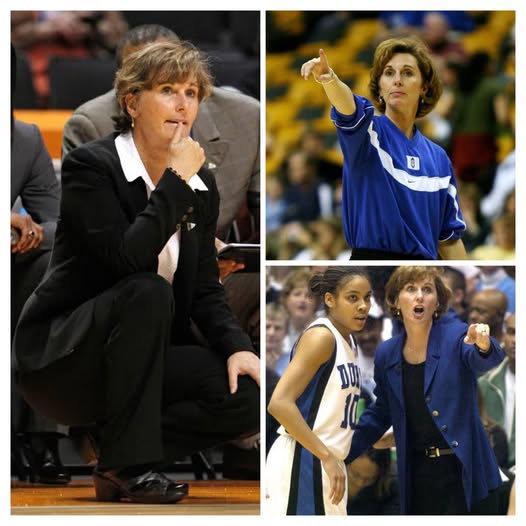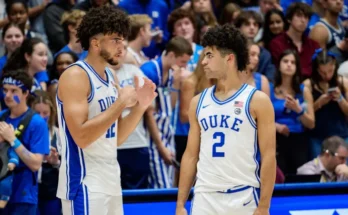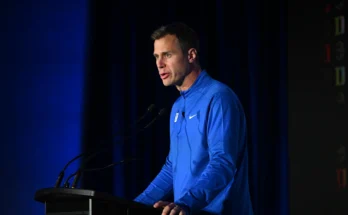DUKE’S GAME-CHANGER: How Gail Goestenkors Took the Blue Devils from Obscurity to National Powerhouse and Forever Transformed Women’s Basketball at Cameron Indoor
When Gail Goestenkors took over the Duke Blue Devils women’s basketball program in 1992, the program was hardly a blip on the national radar. Duke was not known as a women’s basketball school, and few imagined that the hiring of a young, relatively unknown assistant coach from Purdue would become the seismic shift that changed everything. Goestenkors didn’t just improve the program — she built it from the ground up, instilling a winning culture, demanding excellence, and crafting a legacy that endures in the very foundation of Duke women’s basketball. Over the next 15 years, she transformed the Blue Devils into one of the most respected and feared programs in the country, elevating both the university and the sport with her relentless vision and passion.
In 1992, the Duke women’s basketball team was coming off several lackluster seasons with little to show in terms of national relevance. The program had only one winning season in the ACC and had never even made an NCAA Tournament appearance. The hiring of Goestenkors signaled a new direction, though few understood at the time just how monumental her arrival would be. From the very beginning, her energy and focus set a tone. She wasn’t just coaching to win games — she was building a championship culture from scratch.
Goestenkors demanded discipline, accountability, and an intense work ethic from her players. Her practices were grueling and meticulously planned, and she held herself and her staff to the highest standards. Slowly but surely, the culture began to shift. Recruits began to take notice. Duke was no longer just a prestigious academic institution with a men’s basketball dynasty — it was becoming a place where top-tier female athletes wanted to compete. By 1994, just her second year, the Blue Devils posted their first winning record in ACC play. And by 1995, Duke made its first-ever appearance in the NCAA Tournament. The tide was turning.
The late 1990s marked the beginning of a dominant stretch that would see Duke emerge as a consistent national contender. Goestenkors recruited players who bought into her vision — players who were tough, unselfish, and mentally strong. Names like Alana Beard, Iciss Tillis, and Monique Currie became synonymous with Duke excellence. Under her leadership, the Blue Devils reached seven ACC Tournament finals, won four regular-season ACC championships, and made ten straight NCAA Tournament appearances from 1998 to 2007. The program’s success wasn’t a fluke; it was the result of years of painstaking development and unrelenting competitiveness.
The crowning achievements of Goestenkors’ tenure were the national championship game appearances in 1999 and 2006. In 1999, just seven years after taking over a struggling team, she led Duke to its first-ever Final Four and national championship game. Though the Blue Devils fell to Purdue in the title game — a team Goestenkors had helped build as an assistant — the run was historic. It announced to the country that Duke women’s basketball had arrived. In 2006, the Blue Devils again made it to the national title game, this time falling to Maryland in an overtime thriller. While a national championship eluded her, the consistency and competitiveness of her teams placed Duke among the elite programs in the nation.
Goestenkors’ coaching style was marked by adaptability and precision. Her teams were known for their suffocating defense, ball movement, and selfless play. She emphasized fundamentals but was never afraid to innovate. She tailored her system to her players’ strengths, which allowed her to get the most out of her rosters. But beyond the X’s and O’s, it was her ability to inspire and connect with her players that truly set her apart. Many of her former athletes speak not just of her tactical brilliance, but of her mentorship, her investment in their personal growth, and the belief she instilled in them to strive for greatness.
Her accolades are numerous: ACC Coach of the Year multiple times, Naismith Coach of the Year in 2007, and induction into multiple halls of fame. But her legacy is not just etched in awards or wins — it’s embedded in the culture she created. Goestenkors didn’t just win games; she built a dynasty that respected the sport and elevated its status on campus and nationally. At a time when women’s college basketball was still fighting for recognition, her success at a school better known for men’s hoops was groundbreaking.
It’s also worth noting that her influence extended beyond Durham. As an assistant and later head coach for USA Basketball, Goestenkors helped shape the U.S. women’s national team, contributing to its global dominance. Her reputation as a leader, strategist, and program builder earned her widespread respect from peers across the coaching landscape. She wasn’t just a Duke legend — she was a pioneer in women’s sports.
In 2007, Goestenkors made the difficult decision to leave Duke to take over the Texas Longhorns program. It marked the end of an era, but her departure did nothing to diminish the legacy she left behind. Duke continued to benefit from the foundation she had built. The facilities, the national respect, the expectations — all were the result of her vision and labor. Her fingerprints remain all over the program to this day.
The impact of Gail Goestenkors can also be seen in the countless coaching trees she’s inspired. Former players and assistants who learned under her have gone on to coach at various levels, carrying with them the values and philosophies she championed. In a sport where longevity and consistency are difficult to maintain, her ability to sustain excellence for 15 years is a testament to her adaptability, leadership, and unwavering commitment to her principles.
When looking back on her tenure, what stands out isn’t just the record — though her 396 wins at Duke are impressive — but the transformation she orchestrated. She turned a program with no history into a perennial powerhouse. She brought visibility and respect to women’s basketball in a way few coaches have. And most importantly, she created a culture of excellence that made Duke not just a place where you could win, but a place where you were expected to.
Gail Goestenkors didn’t just coach basketball — she changed the perception of what was possible at Duke for women’s athletics. She made Cameron Indoor Stadium a stage not just for the men’s team but for the women to shine on as well. Her presence commanded attention, and her success demanded respect. She balanced intensity with compassion, discipline with encouragement, and competitiveness with camaraderie. Her players weren’t just athletes — they were ambassadors for a program and a vision she had from day one.
Today, as women’s basketball continues to grow in visibility and popularity, the seeds planted by pioneers like Goestenkors are in full bloom. Programs like South Carolina, LSU, Iowa, and others stand on the shoulders of trailblazers who fought for excellence and equity long before it was fashionable. At Duke, her legacy continues to be a north star — a reminder that greatness is possible when belief meets preparation.
The story of Duke women’s basketball cannot be told without Gail Goestenkors. She is the cornerstone of the program’s identity and the architect of its rise. While others have come and gone, her era remains the golden age — the time when everything changed. And though she may no longer pace the sidelines of Cameron Indoor, her presence is still felt in every practice, every game, and every young woman who dares to dream big in a Blue Devils uniform. Gail Goestenkors didn’t just build a program — she built a legacy. One that will echo through the halls of Duke forever.



